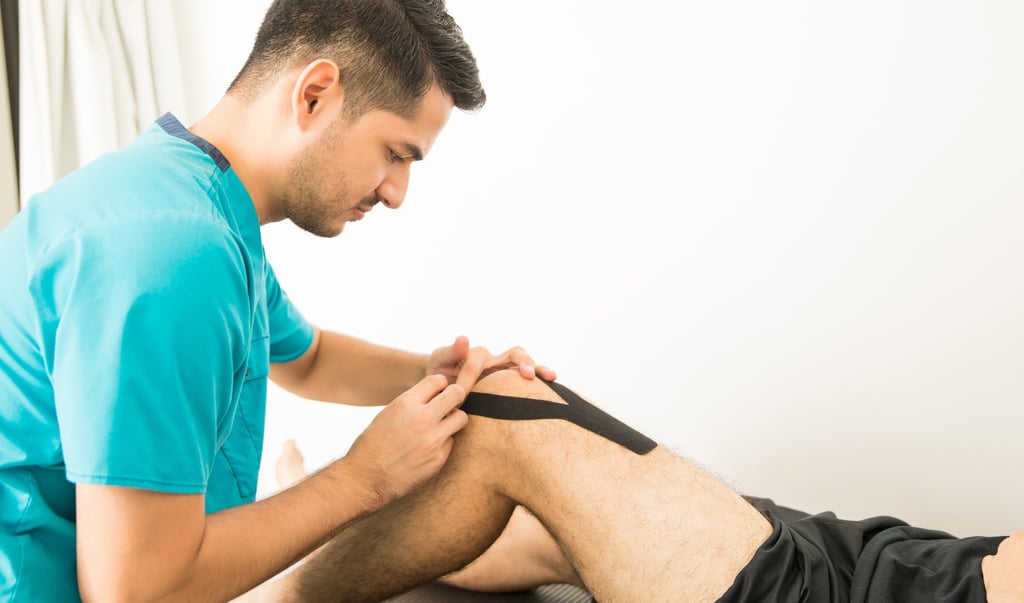Kinesiotaping
Kinesiotaping, commonly known as Kinesiology Taping, is a therapeutic taping technique designed to provide support and stability to muscles and joints without restricting movement. Unlike traditional athletic tape, kinesiology tape is flexible, breathable, and mimics the skin’s elasticity, allowing for a greater range of motion while offering targeted support. It’s frequently used in sports medicine, rehabilitation, and injury prevention, making it a popular choice among athletes, physiotherapists, and fitness enthusiasts alike.
MSKSPORT
2/15/20252 min read


What is Kinesiotaping?
Kinesiotaping (also known as kinesiology taping) is a therapeutic technique that uses a special elastic tape to provide support to muscles and joints without restricting movement.
Unlike traditional sports tape, kinesiology tape is lightweight, flexible, and designed to mimic the elasticity of your skin. This allows it to move with your body while offering the support you need for recovery or performance enhancement.
Benefits of Kinesiotaping
Kinesiotape is more than just a fashionable accessory. When applied correctly, it can offer a wide range of benefits:
Pain Relief: Reduces pressure on pain receptors and promotes better circulation.
Reduced Swelling and Inflammation: Helps improve lymphatic drainage and decrease swelling in the affected area.
Joint and Muscle Support: Provides stability without limiting your range of motion.
Improved Movement Patterns: Guides muscles and joints into healthier positions, supporting proper movement.
Faster Recovery: Helps injured tissues heal more efficiently by improving blood flow and reducing stress on the area.
What to Expect During Your Kinesiotaping Session
If kinesiotaping is part of your treatment plan, here’s what you can expect:
Assessment: We’ll assess your condition and determine how kinesiotaping can best support your recovery.
Application: The tape will be carefully applied to the affected area, customized to the level of support or decompression you need.
Education: We’ll teach you how to care for the tape and how long to keep it on (usually 3–5 days).
Kinesiotaping is safe, non-invasive, and comfortable to wear during daily activities, workouts, and even showers!
How to Apply Kinesiotape
Proper application of kinesiology tape is crucial for it to be effective. Here are some general tips:
Clean the skin before applying to remove oils or lotion.
Cut the tape to the desired length and round the edges to prevent peeling.
Stretch and apply the tape according to your needs—light stretch for support, moderate stretch for stabilization.
Rub the tape after application to activate the adhesive for a more secure hold.
While it’s easy to learn the basics, seeking professional advice from a physiotherapist ensures the tape is applied correctly for your specific condition.
Is Kinesiotaping Right for You?
Kinesiotaping can be a valuable tool for managing pain, supporting injuries, and enhancing performance. Whether you’re a weekend warrior, professional athlete, or someone recovering from an injury, it might be worth a try.
However, it’s important to remember that Kinesiotaping is not a standalone treatment. It’s most effective when used as part of a comprehensive rehabilitation plan that includes exercises, manual therapy, and proper guidance from a qualified professional.
Conclusion
Kinesiotaping is more than just colorful tape you see on athletes—it’s a science-backed method for improving movement and supporting recovery. Consult your physiotherapist to determine if kinesiology tape is right for your needs and get the best results from this simple yet powerful tool.
Read more
Physiotherapy in Bali
Your Path to Optimal Health.
Contact us
Subscribe us
© 2024. PT BUMI MEDIKA BALI. All rights reserved.
